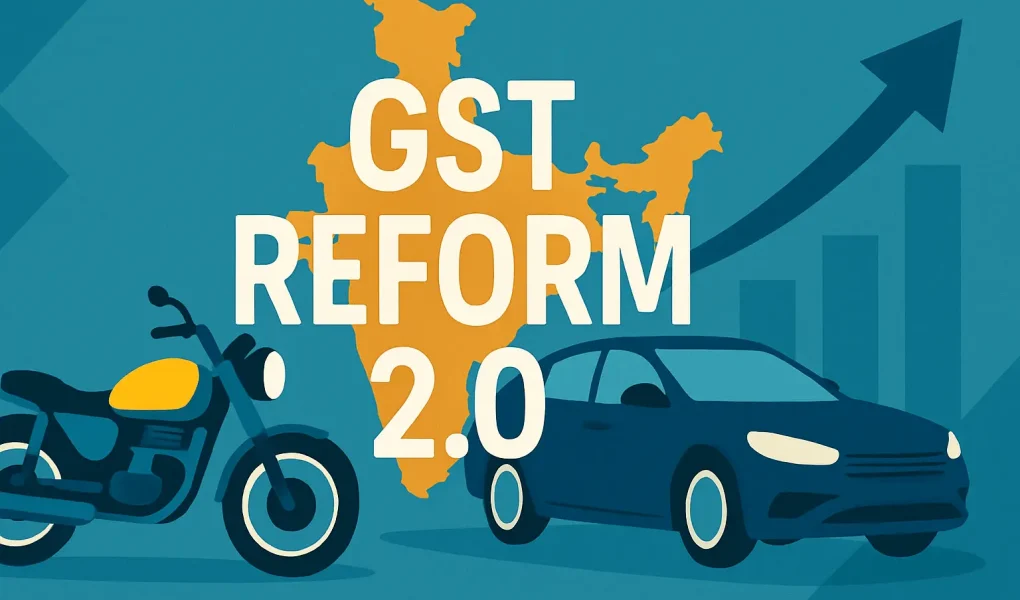Introduction to GST Reform 2.0 and Key Changes
Prime Minister Narendra Modi announced the transformative GST Reform 2025 India, popularly known as GST 2.0, on August 15, 2025. Following the historic GST Council meeting on September 3, 2025, these reforms are set to take effect from September 22, 2025. The new tax structure will significantly impact the GST changes auto industry in India, particularly in motorcycle and automobile pricing and taxation.
Simplified GST Slabs for Motorcycles & Automobiles: What Has Changed?
GST 2.0 reduces the tax slab complexity from four to three main slabs and introduces a higher slab for luxury items:
| Vehicle Category | Old GST Rate | New GST Rate (from Sep 22, 2025) |
|---|---|---|
| Motorcycles up to 350cc | 28% | 18% |
| Motorcycles above 350cc | 28% + cess (~40-50%) | 40% (flat) |
| Small cars (petrol ≤1200cc, diesel ≤1500cc, ≤4000mm) | 28% + cess (~35-40%) | 18% |
| Large cars, SUVs (petrol >1200cc, diesel >1500cc, >4000mm) | 28% + cess (~45-50%) | 40% (flat) |
| Electric vehicles (2/3 wheelers) | 5% | 5% |
| Auto parts & components | 28% | 18% |
| Commercial vehicles, buses, trucks | 28% | 18% |
Impact of GST 2.0 on Motorcycles and Two-Wheelers in India
-
Goods and Services Tax (GST) rate cut for motorcycles in India 2025 up to 350cc bikes from 28% to 18% lowering prices, benefiting mass-market models like Hero Splendor, Bajaj Pulsar, and Royal Enfield Classic 350.
-
Higher GST slab for motorcycles in India above 350cc at 40% increases taxes on premium motorcycles, affecting buyers of KTM, Harley-Davidson, and Triumph.
-
The retention of a 5% rate on electric two-wheelers encourages sustainable transportation.
GST 2.0 Impact on Automobiles: Small Cars to Luxury SUVs
-
Small cars as well as hybrids under 1200cc petrol and 1500cc diesel with a length below 4000mm now attract an 18% GST as opposed to nearly 30-40% earlier.
-
Larger and luxury vehicles shifted from approximately 50% tax (including cess) to a flat 40% GST slab, simplifying what consumers pay.
-
Reduced GST on auto parts streamlines manufacturing costs and supply chain efficiency.
Industry & Consumer Response to GST 2.0
-
Auto industry leaders welcome the reform, anticipating increased demand in the price-sensitive segments like motorcycles and small cars.
-
Consumers benefit from the GST rate reduction on cars in India and easier compliance.
-
Concerns remain regarding cess removal’s impact on government revenue and pricing for luxury vehicles.
Important GST 2.0 Dates and Next Steps for Buyers
-
Announcement: August 15, 2025
-
GST Council meeting: September 3, 2025
-
Implementation: September 22, 2025
-
Compensation cess removal deadline: October 31, 2025
Buyers should leverage these tax benefits while manufacturers and dealers prepare for pricing realignments.
Conclusion
GST 2.0 transforms India’s GST landscape with major benefits for the motorcycle and automobile sectors. Entry-level bike and car buyers will see tangible tax relief, while luxury segments experience increased rates balanced by cess removal. Simplified slabs and clearer compliance pave the way for a more competitive, transparent, and consumer-friendly auto market.
(This detailed coverage of the new GST benefits is available on Streaming Words.)




